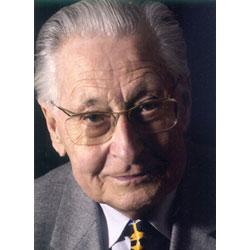
Heinz Wunderlich, organ virtuoso, teacher, and composer, died on March 10, 2012, in Großhandsdorf, Germany, at the age of 92. He was predeceased by his first wife, Charlotte, in 1982, and by his second wife, the violinist Nelly Söregi Wunderlich, in 2004. He is survived by three daughters and a stepson.
Wunderlich’s early study was with his father and the local church organist. At the early age of sixteen, he was admitted to the Academy of Music in Leipzig, where he was the youngest student. While studying with Karl Straube and Johann Nepomuk David, he began his lifelong interest in the music of Max Reger.
Despite growing up and living in the tumultuous time between the First World War and the Second World War, he held prestigious positions and become well known for his many recitals and improvisations.
Since he was trapped in the East, his career could not advance until he was able to escape in 1958 with his wife and daughters. He took the position of music director at St. Jacobi in Hamburg. It was there that he oversaw the reconstruction of the well-known Arp Schnitger organ, which had been removed during the war. For many years he was also Professor of Organ and Improvisation at the Hamburg College of Music, where he met his second wife.
As he began to concertize throughout the world, including several tours with his choir, the Kantorei St. Jacobi, his fame grew exponentially. In the United States alone he made twenty-six tours. Students came from all over the world to study with him—many to study the works of Max Reger, as Wunderlich was one of the few musicians who was in a direct line of succession with Reger.
Wunderlich leaves quite an extensive body of organ works, as well as choral music. He remained active as a recitalist until his 91st year, when he decided not to play any more. His death is a huge loss to the organ world. (See “Heinz Wunderlich at 90,” by Jay Zoller, The Diapason, April 2009, pp. 19–21; “80th Birthday Tribute—Heinz Wunderlich,” by David Burton Brown, The Diapason, April 1999, p. 18; “Heinz Wunderlich at 74,” by David Burton Brown, The Diapason, April 1994, p. 6; and “The Published Organ Works of Heinz Wunderlich,” by David Burton Brown, The Diapason, April 1994, pp. 12–13.)
—Jay Zoller


